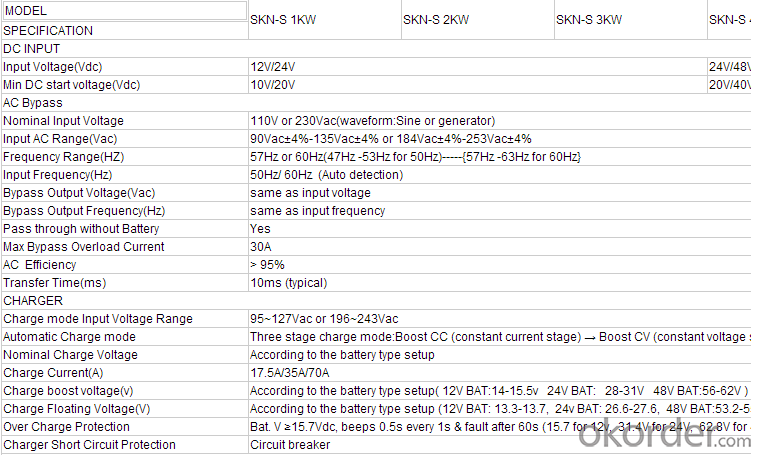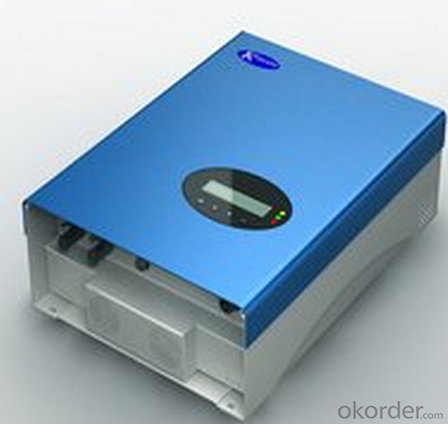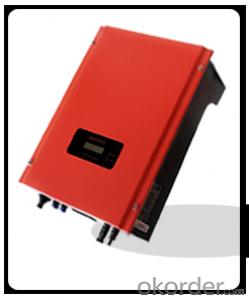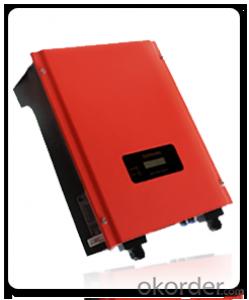Solar Inverters Sunteams 1500 to 3000 US ETL from China
- Loading Port:
- China main port
- Payment Terms:
- TT or LC
- Min Order Qty:
- 1 watt
- Supply Capability:
- 10000000 watt/month
OKorder Service Pledge
OKorder Financial Service
You Might Also Like
Description:
The Sunteams (US) 1500 ~5000 series isapplicable to various rooftops and small scale photovoltaic grid connected power plants. Their nominal output powers are 1.5 kW, 2 kW, 2.5 kW, 3 kW, 4 kW and 5kW respectively with Certificate ETL (220V/60HZ).
This series is transformerless and has a wide range of MPPT input voltage. Itsmaximum conversion efficiency and MPPT tracking accuracy reach 97.6 % and 99.5% respectively. The maximum DC voltage reaches 550 V. Its multilingualLCD display facilitates easy operation. It has waterproof direct plug-interminals. It has overvoltage, islanding, short-circuit, overloading andoverheating protection functions. Its IP65 protection degree will ensure itruns well in various tough environments.
These units are available with or without wirebox.


FAQ:Pls introduce more about CNBM?
CNBM is a China state owned company ,one of Global Fortune 500 .
- Q:How does a solar inverter impact the payback period of a solar system?
- A solar inverter can have a significant impact on the payback period of a solar system. The efficiency and reliability of a solar inverter can affect the overall energy production and performance of the solar system. A high-quality inverter can optimize the conversion of solar energy into usable electricity, maximizing the system's output and reducing energy losses. This improved efficiency can shorten the payback period by increasing the amount of electricity generated and therefore the savings on utility bills. Additionally, a reliable inverter can minimize maintenance and replacement costs, further enhancing the financial returns of the solar investment.
- Q:How does a solar inverter handle excess power production?
- A solar inverter handles excess power production by converting the surplus energy generated by the solar panels into usable AC power. This excess power is either fed back into the grid or stored in batteries for later use, depending on the type of solar system setup.
- Q:What is the difference between a string inverter and a micro inverter?
- A string inverter is a type of solar inverter that is connected to a series of solar panels, converting the DC power produced by the panels into AC power for use in homes or businesses. A micro inverter, on the other hand, is installed on each individual solar panel, converting the DC power into AC power at the panel level. The main difference between the two is that a string inverter handles the entire string of panels, while a micro inverter operates on a per-panel basis. This means that micro inverters offer advantages such as increased energy production, better module-level monitoring, and improved system flexibility, but they can also be more expensive and complex to install compared to string inverters.
- Q:Can a solar inverter be used in systems with different module types?
- Yes, a solar inverter can be used in systems with different module types. Solar inverters are designed to convert the direct current (DC) generated by the solar panels into alternating current (AC) that can be used to power various household appliances and be fed into the electrical grid. They are typically compatible with a wide range of module types, including monocrystalline, polycrystalline, and thin-film solar panels. However, it is important to ensure that the inverter's specifications and capacity align with the specific module types being used to ensure optimal performance and efficiency.
- Q:Can a solar inverter be used for both single-phase and three-phase applications?
- No, a solar inverter cannot be used for both single-phase and three-phase applications. The design and functionality of a solar inverter are specific to either single-phase or three-phase systems.
- Q:Can a solar inverter be used with a generator as a backup power source?
- Yes, a solar inverter can be used with a generator as a backup power source. The solar inverter can be connected to the generator's power output, allowing it to convert the generator's AC power into usable DC power for the solar panels. This enables the solar panels to continue generating electricity even when there is no sunlight, providing a reliable backup power supply.
- Q:What is the role of a solar inverter in a net metering system?
- The role of a solar inverter in a net metering system is to convert the direct current (DC) produced by the solar panels into alternating current (AC) that can be used to power appliances in a home or business. It also ensures that any excess electricity generated by the solar panels is fed back into the grid, allowing the user to earn credits or be compensated for the excess energy.
- Q:Can a solar inverter be used in a ground-mounted solar tracking system?
- Yes, a solar inverter can be used in a ground-mounted solar tracking system. In fact, the solar inverter is an essential component of the system as it converts the DC electricity generated by the solar panels into AC electricity that can be used to power appliances and be fed into the grid. The solar inverter's functionality remains the same whether it is used in a ground-mounted solar tracking system or a fixed tilt system.
- Q:Can a solar inverter be used in regions with high levels of air pollution?
- Yes, a solar inverter can be used in regions with high levels of air pollution. The performance of the solar inverter may be slightly affected due to the reduced sunlight reaching the solar panels, but it can still convert the available solar energy into usable electricity. Regular maintenance and cleaning of the solar panels may be required to mitigate the impact of air pollution on their efficiency.
- Q:Can a solar inverter be used in conjunction with a backup generator?
- Yes, a solar inverter can be used in conjunction with a backup generator. In a hybrid system, the solar inverter manages the flow of electricity from both the solar panels and the backup generator, ensuring a seamless transition between the two power sources. This allows for continuous power supply even when solar energy is not available, providing an efficient and reliable solution.
1. Manufacturer Overview |
|
|---|---|
| Location | |
| Year Established | |
| Annual Output Value | |
| Main Markets | |
| Company Certifications | |
2. Manufacturer Certificates |
|
|---|---|
| a) Certification Name | |
| Range | |
| Reference | |
| Validity Period | |
3. Manufacturer Capability |
|
|---|---|
| a)Trade Capacity | |
| Nearest Port | |
| Export Percentage | |
| No.of Employees in Trade Department | |
| Language Spoken: | |
| b)Factory Information | |
| Factory Size: | |
| No. of Production Lines | |
| Contract Manufacturing | |
| Product Price Range | |
Send your message to us
Solar Inverters Sunteams 1500 to 3000 US ETL from China
- Loading Port:
- China main port
- Payment Terms:
- TT or LC
- Min Order Qty:
- 1 watt
- Supply Capability:
- 10000000 watt/month
OKorder Service Pledge
OKorder Financial Service
Similar products
New products
Hot products
Related keywords































